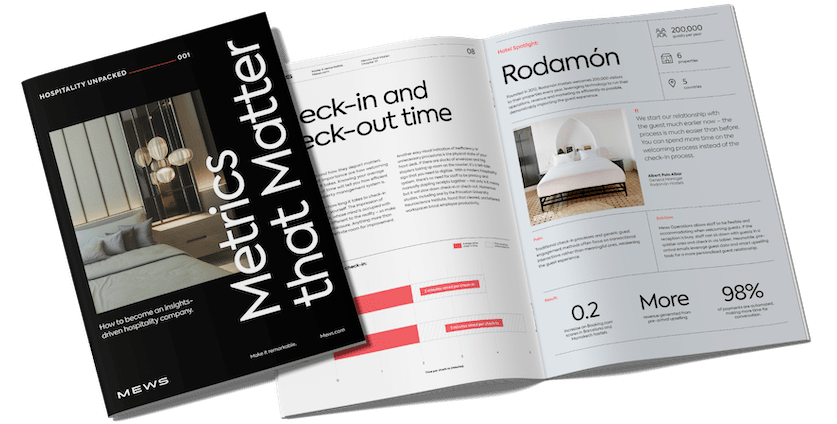Are you wondering what ADR, hotel and revenue all have in common? Well, ADR stands for a hotel’s Average Daily Rate, which is a key metric for understanding the average rental income generated by having a room occupied each day. It’s an invaluable calculation for a hotelier’s revenue management strategy, giving a better idea of the hotel's performance compared to other hotels of the same size, clientele and location.
To calculate ADR, you divide total room revenue by the number of rooms sold, factoring in only the revenue that is generated from paying for the room itself.
Let’s get into more details about this metric, including why it’s important, when to use it, when not to, and most importantly, how to maximize it in today’s day and age.
Table of contents
What is Average Daily Rate (ADR)?
An Average Daily Rate is an important hotel KPI that’s based on calculating the average rate or price of a hotel room sold on any given day. As mentioned, this rate is super helpful for comparing how well your hotel is doing versus hotels of a similar caliber. Ultimately, it’s one of the most important metrics when looking to draw conclusions from hotel data analytics.
Since room rates can vary depending on where the hotel is located, the time of year, or the type of hotel, ADR can help determine the average amount of income that’s being generated by occupied rooms. While occupancy indicates how many rooms are actually sold; ADR indicates the price at which these are being sold for, or the average room rates.
Initially, rooms are often booked at promotional rates, and as the reservation date approaches, prices tend to increase – this can sometimes skew the Average Daily Rate. By considering both occupancy and ADR together, however, hoteliers can gain valuable insights into the overall revenue generation from room sales.

How do you calculate Average Daily Rate (ADR)?
Average Daily Rate can be calculated by taking room revenue and dividing it by the number of rooms sold. It uses the following formula:
ADR = Room revenue / Rooms sold
In this equation, Room Revenue is the total gross revenue generated from hotel room rentals and the net of any discounts. It does not include revenue from room service, movie rental, or the mini bar - all of which are important metrics for a hotel, and budget properties above all.
ADR essentially takes into consideration the average price the guests pay for a hotel room, but the rooms sold can, of course, vary from structure to structure based on the type of rooms, i.e. whether a hostel counts a dorm bed as a room sold, or only does this once the entire room is booked.
On the other hand, rooms sold refers to the number of rooms occupied and paid for on a given day. ADR does not take into consideration the revenue earned in other areas of the hotel, and should not take into mind any complimentary rooms, or rooms occupied by non-paying guests.
To manage these exceptions, an adjustment product can be utilized to effectively apply a rebate when comping a room for a staying guest, ensuring that the revenue metrics remain accurate while providing the necessary discount. Additionally, for non-paying guests or employees, a House Use block can be employed. This method allows the hotel to allocate rooms for internal use without impacting the ADR, thereby maintaining the integrity of financial reporting.
Why is Average Daily Rate important in the hotel industry?
The Average Daily Rate is important because it helps your hotel understand the key trends, any possible challenges that might be present, and thereby design a strategy to address the current panorama based on peers in your hotel’s comp set across different time periods. This allows your hotel to identify trends and patterns in guest behavior, which is crucial for creating special offers, promotional efforts, and to help manage inventory throughout the year depending on demand.
ADR is a key point of comparison for revenue management and pricing strategy, performance measurement, budgeting and forecasting, profitability analysis, developing your sales and marketing strategy, and improving operational efficiency to improve the guest experience and satisfaction levels. Hoteliers can use this metric to get comprehensive insights and make data-driven decisions designed to enhance profitability and revenue optimization.
What are the variables influencing hotel ADR?
There are several variables that influence a hotel’s Average Daily Rate, which can help optimize pricing strategies and improve revenue management.
Location
Location is everything when it comes to how you market your hotel and how you adjust your hotel’s daily rate. For example, in summertime, a beach front property is much more desirable than a hotel in the city center. However, throughout the year, urban hotels tend to have higher ADRs than its rural counterparts, due to higher demand and operational costs. If your hotel is close to business districts or popular attractions, then you might also have a higher ADR.
Seasonality and demand
Seasonality is one of the biggest factors influencing ADR. During peak season or major events, ADR will be higher. During the low season, or in the middle of the week, ADR often decreases.
Demand is another crucial factor affecting ADR. When demand is high, rates are high, and vice versa. Events, conferences, festivals and sporting events will also boost ADR. Seasonality and demand are strongly interlinked.
Hotel classification
A 5-star hotel may have a higher rate compared to budget and economy hotels. As well as this, hotels can generally charge a higher average daily rate when there are more amenities available, like spas, gym classes, or fine dining.
Economic situation
Economic conditions will also greatly impact travel budgets and ADR. For example, during a recession, ADRs tend to go down. Inflation, on the other hand, will generally cause prices to rise so that hotels can remain profitable.

How Mews can help you optimize ARR
Getting the most out of your Average Room Rate isn’t just about setting the right price – it’s about having the right tech work for you. Mews gives you the tools to stay one step ahead, with built-in features that support smarter pricing, stronger performance and a better guest experience.
- Automated rate management
With Atomize, a Mews company, you can automatically adjust room rates based on real-time demand and occupancy. This lets you stay competitive while increasing ADR by - Dynamic pricing strategies
Let your pricing respond to market shifts. Dynamic rates help you stay profitable during peak times and smart during slower ones. - Data-driven insights
Get a clear view of guest behavior and booking trends. Use that data to fine-tune your pricing and target the right segments. - Better guest experiences
Mews supports seamless, modern stays—think self-service, upgraded amenities and smart tech. A better experience increases perceived value, which supports stronger room rates. - Smarter segmentation
Easily tailor rates and packages for different types of guests—like business travelers, couples or families—so you’re offering what each group values most - Optimized distribution with Mews Booking Engine
Drive more direct bookings and reduce reliance on commission-heavy third parties. With Mews, it’s easier to manage distribution and protect your margins.
Difference between ADR, APR, ARR and RevPAR
ADR, APR, ARR and RevPAR are key metrics for evaluating a hotel’s financial performance and operational efficiency. Let’s look at how these metrics compare.
RevPAR, out of all of these metrics, is the most unique. While ADR gives hoteliers information about the average price at which rooms are sold, RevPAR incorporates both occupancy and rate – making it critical for overall revenue management.
ADR vs. RevPAR
The main difference between ADR and RevPAR is that where ADR is mainly focused on the average rate charged for each room sold, RevPAR incorporates occupancy as well. Overall, RevPAR will give a better picture of revenue performance.
ADR vs. APR
While ADR reflects the average rate paid by guests, APR is the average advertised or published rate before discounts or special rates are applied. It allows the hotel to understand standard pricing.
ADR vs ARR
ADR and ARR are often used interchangeably. However, while ADR measures the average revenue earned from each occupied room daily, ARR typically looks at a longer period - taking into account the total room revenue and the total number of rooms available.
When should we use ADR?
We should use Average Daily Rate to regularly monitor and make pricing adjustments based on occupancy levels and current market conditions. We can also analyze ADR before launching a promotional campaign to see how effective the campaign was in impacting revenue. Hotels can also compare it with their competition to refine their pricing strategies. It is a great tool for revenue management, price optimization and forecasting.
Overall, the metric is useful for comparative analysis with competitors, historical analysis against your own performance, for operational decisions, and for overall strategic planning and budgeting decisions, like how much to budget for personal costs based on occupancy rates.
How can you increase ADR at your hotel?
Increasing ADR is about combining strategies to enhance a hotel’s perceived value, optimizing pricing strategies, and creating effective marketing strategies tailored to the right segments. Below are some ways that you can increase ADR.
Enhance the guest experience
A hotel’s perceived value has a lot to do with the guest experience, and the guest experience is defined by service excellence and the quality of amenities offered. It’s also important to take pride in your hotel’s installations, regularly renovating rooms and common areas, which will positively influence the guest experience.
Find ways to diversify and upsell
By diversifying your offerings, you can target different clients with different room categories. You can also upsell additional features to different target audiences that are perhaps less price sensitive. Importantly, you can train staff to upsell throughout the guest experience and create package deals that bundle different services to boost the average spent.
Optimize pricing strategies
Dynamic pricing, length of stay discounts and advanced booking rates will all help boost your ADR. Using rate management software will allow your hotel to adjust to the market, whether that be changes in demand, seasonality, events or due to competitor pricing. By giving a discount for those who stay for longer periods of time, or for those who book in advance, you can reserve higher rates for those who book at the last minute, and also ensure higher overall revenue.
Target your marketing efforts
Find ways to target higher-value segments like corporate clients and luxury travelers, or position your hotel as a good place to host special events. You can also give incentives to book directly or develop a loyalty program to reward guests with special rates. As you create targeted marketing efforts, just be sure to maintain a positive reputation online and thus make your higher ADR justifiable.
Leverage technology
By leveraging technology like revenue management systems and booking engines, you can find ways to better promote direct bookings and easily identify upselling opportunities to boost your ADR. You can also better analyze data and practice demand forecasting to make better pricing decisions.

What do we have to know about ADR?
ADR is such an important metric, but what is it about it that we must understand? As the name suggests, Average Daily Rate measures how much revenue is made per room on average. As hoteliers, you want to a high ADR because it indicates that the hotel is making increasingly more money from room sales.
Of course, there are ways to increase ADR by boosting price per room (and utilizing other price management strategies). Some of these strategies could be promotions, upselling, as well as offering complimentary services such as a free city walking tour or a shuttle to and from the airport. While prices depend on the current market trends and seasonality, hoteliers should seek to match the prices to demand at any given time.
We’ve already mentioned that this rate can be used to determine how well a hotel is performing against similar hotels, but it can also be compared against the hotel’s own historical performance to determine trends, seasonal impact and to understand the effectiveness of promotions and different pricing strategies.
ADR can be misleading
While this metric can be useful to get a better picture of how your hotel is doing, it can be misleading at times. For example, if you have a booking for $600, your ADR will increase significantly - but your sales or revenue won’t be greatly impacted. And finally, this metric doesn’t consider hotels with different space categories, different rates, promotions, or properties with add-ons such as room service etc.
Alternative metrics
Because ADR can be misleading, it’s important to look closely at KPIs like revenue per available space or revenue per guest. These give similar insight, but with a clearer picture of how well the property is performing operationally. GOPPAR (or gross operating profit per available room) can also provide stronger intel on how well a property is performing on a high level, as well as point out inefficiencies in reaching these profit goals.
If you’d like to know more about the new generation of metrics, including both RevPAG and TRevPAR, download The Metrics that Matter. This report dives into how to make your operations more efficient and more profitable.
An example of Average Daily Rate
Now that we understand how to calculate the rate, let’s take a look at some examples to see it live in action.
Say, for example, your average room revenue in August (peak season) was $400,000 and the number of rooms sold that month was 2,000. The ADR in August would be $200.
Now, imagine you have 200 rooms to sell, and you only sell 175 of those rooms. Your occupancy rate would be a respectable 87%. If you were to consider this in terms of ADR, the same 200 rooms may cost $250 during high season and $150 during low season. You would have quite a range of revenue here: $43,750 during the high season versus $26,250 in the low season.
These examples help you to demonstrate that if you’re looking to increase the amount of revenue generated by room sales, then shooting for a higher ADR is a great strategy.
And through an effective pricing strategy and promotions such as discounts for booking a multiple day stay, you can effectively manage the revenue streams.
This figure can be used to calculate the revenue per available room (also known as RevPAR). While the ADR shows how much is made per room per day, RevPAR shows the hotel’s ability to fill the available rooms at the average rate, so they are interconnected.
Conclusion
As far as revenue is concerned in a hotel, ADR is an important figure but it’s not the only one to consider. This is because it doesn’t provide a holistic picture of a hotel’s entire revenue successes, nor does account for ancillary revenue or hotels with varying room types. While this figure does tend to increase if a hotel’s prices increase, this number on its own is not enough to get a full overview. It’s important to look at all the different metrics together.
For example, if occupancy falls, overall revenue might be lower. Moreover, it doesn’t take into consideration commissions to OTAs or money that is reimbursed to the client should there be a problem, since it only measures whether the room was sold.
That said, ADR can be used as part of a holistic hotel revenue strategy, which can include (but is not limited to) pricing strategies, promotions and other methods to increase revenue. Segmentation can also be used as part of this strategy because by fully grasping clients’ needs and barriers to entry, hoteliers can understand what they need to do in terms of prices to pull that client in. This could be providing complimentary services, implement a loyalty program, or providing lower prices for direct bookings. All these factors can help contribute to increased revenue.
Boosting ADR is useful to help increase revenue, coupled with upselling, cross-selling and segmentation. And finally, it’s an important KPI to better understand the hotel’s and other campaigns’ overall performance when used together with other data points.

How does your property measure performance? With an almost endless amount of data available, tracking the right metrics is key for success – and we’re here to guide you.

2026 Hospitality Industry Outlook
Download now
Table of contents
Hospitality hot takes straight to your inbox



.webp)
